What Are the Benefits of Having Beef Cattle What Are the Benefits of Having Beef Cattle
Terminal Updated on May 8, 2021 by
A generation or two ago, our parents and grandparents viewed beef as a nutritious health nutrient.
These days it all seems much dissimilar, and opinion is dissever between whether beefiness is healthful or harmful for our wellness.
This article takes an in-depth look at the nutrition contour and potential health benefits of beef, which is a blazon of red meat.
Additionally, we look at some of the potential concerns.
1. Beef has an impressive nutrition contour
First of all, beef is an splendid source of essential nutrients. It contains a wide range of vitamins and minerals.
The post-obit data shows the full nutritional values for beef per 100 grams, based on data from the USDA's FoodCentral Database.
Although the verbal nutrient values will depend on the precise cut of meat, the following data is based on 80% lean ground meat (1).
| Calories/Nutrient | Amount |
|---|---|
| Calories | 254 kcal |
| Carbohydrate | 0 chiliad |
| Fat | sixteen.17 g |
| Saturated fatty | 6.sixteen m |
| Monounsaturated Fat | 7.19 k |
| Polyunsaturated Fat | 0.47 m |
| Protein | 25.25 g |
Vitamins
- Vitamin B12: 104% DV
- Niacin (vitamin B3): 29% DV
- Vitamin B6: 19% DV
- Choline: 15% DV
- Riboflavin (vitamin B2): 13% DV
- Pantothenic acrid (vitamin B5): xi% DV
- Thiamin (vitamin B1): 3% DV
- Folate: 2% DV
- Vitamin Due east: ane% DV
- Vitamin M: 1% DV
Minerals
- Zinc: 57% DV
- Selenium: 37% DV
- Phosphorus: xiv% DV
- Iron: xiv% DV
- Potassium: 6% DV
- Magnesium: 5% DV
- Copper: nine% DV
- Sodium: 3% DV
- Calcium: 2% DV
- Manganese: 0.5% DV
Key Point: Beef is a rich source of protein, B vitamins, zinc, and selenium.
2. Beef provides a large source of Fifty-Carnitine
Fifty-carnitine is a health-promoting compound that the body synthesizes in the liver from the amino acids lysine and methionine (2).
Beef is the all-time dietary source, and other meat products also comprise relatively loftier amounts (3).
In the tabular array below, we can come across the L-carnitine content of beef compared to some other brute foods and plant foods (4);
| Fifty-Carnitine Nutrient Source | Amount of 50-Carnitine (mg) |
|---|---|
| Asparagus (1/2 cup) | 0.1 |
| Beefiness (4oz) | 56 – 162 |
| Cheese | 2 |
| Chicken Breast (4oz) | iii – 5 |
| Cod (4oz) | 4 – 7 |
| Ice-Foam (1/2 loving cup) | 3 |
| Whole Milk (1 cup) | viii |
| Whole Wheat Bread (1 slice) | 0.2 |
Why is L-Carnitine Of import?
Among its numerous functions, L-carnitine plays a role in fatty metabolism.
As role of this, L-Carnitine does the job of transporting fats into our mitochondria where we burn them (v).
It's of import to clarify that our torso tin synthesize sufficient amounts of L-carnitine for general needs, and we don't necessarily demand an external intake.
As a result, deficiencies are rare.
Nevertheless, research suggests that a college dietary intake of L-Carnitine may have some positive wellness impacts.
Heart Wellness
A meta-analysis of randomized trials suggests that L-carnitine improves patient outcomes. Specifically, it exerts an effect on hypertension, oxidative stress, nitric oxide, and inflammation (three).
A further systematic review found that L-carnitine is associated with a 27% reduction in all-cause bloodshed in heart failure patients (4).
Diabetes
A systematic review shows that higher 50-carnitine intake in type 2 diabetes patients improves fasting glucose levels and the overall cholesterol profile (5).
Weight Loss
According to a systematic review and meta-analysis of nine randomized controlled trials, subjects using L-carnitine supplementation lost "significantly more weight" than the command group (half-dozen).
All the same, it is of import to annotation that each of these benefits was noted in participants taking supplementary carnitine.
In other words, we can't automatically presume that the amounts present in beefiness would have the same potential benefits.
On the other hand, research demonstrates that the assimilation charge per unit of carnitine from supplements is poor in comparison to beef.
Supplementary doses of synthetic carnitine are usually around 500-600 mg, of which our torso only absorbs 14-eighteen% of the compound (vii).
By comparing, beef provides 56-162 mg of carnitine per 4 oz (112-gram) serving. According to existing trials, dietary carnitine has a bioavailability of approximately 54-87% (7).
Cardinal Point: L-carnitine is a compound that naturally occurs in beef. Based on research into carnitine supplementation, information technology seems to take a positive impact on various health markers.
iii. Beef Provides the "Principal Antioxidant" Glutathione
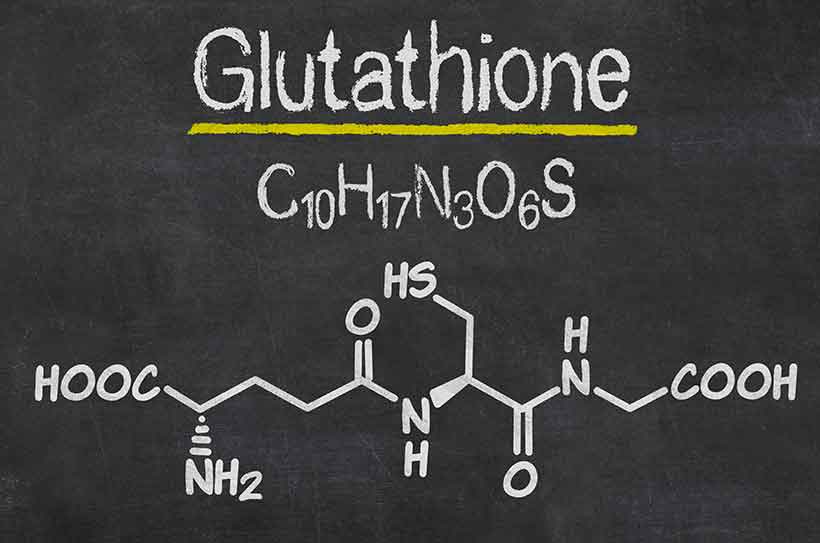
Unremarkably known as the 'master antioxidant,' glutathione has a score of research linking information technology to (viii);
- Anti-crumbling benefits
- Increasing longevity
- Preventing disease
- Reducing the adventure of chronic illness
- Strengthening the immune arrangement
Equally a fundamental player in the homo immune system, glutathione helps to protect every cell in our torso from cellular harm, which tin pb to many chronic diseases.
On the other hand, a deficiency in glutathione appears to contribute to oxidative stress and inflammation (9).
Every bit a result, maintaining sufficient glutathione levels seems to be of import for homo health.
Endogenous Glutathione Product and Dietary Sources
Firstly, the human torso produces glutathione endogenously.
In other words, our body uses raw materials (in this case: amino acids) to make glutathione.
For this process to occur, the body requires adequate levels of the amino acids cysteine, glutamate, and glycine (ten).
These amino acids are known as glutathione precursors, and each of these amino acids is present in beef.
On the positive side, beef also contains a reasonably loftier source of consummate (preformed) dietary glutathione (11, 12).
Key Betoken: Keeping our glutathione levels high is disquisitional for expert health, and beef is a food that may help us to achieve this.
4. Beef is High in Protein
There are numerous reasons why we should strive to ensure a sufficient protein intake and these include;
- Amino acids (proteins) are the building blocks our body uses to repair and make bone, skin, and cartilage (13).
- Sufficient poly peptide intake helps u.s.a. to build and maintain lean musculus mass (14).
- Out of all macronutrients, dietary protein appears to be the most satiating, and it may help to discourage food cravings (15).
Beef is packed with amino acids, and it is one of the most consummate sources of protein in the human being nutrition (16).
For instance, a cooked 6 oz (170g) portion of 80% lean beef provides 36.v grams of protein (1).
Should nosotros opt for a leaner variety of beefiness, the protein content can be even higher. For 95% lean ground beefiness, a cooked half dozen oz (170g) serving provides 43 grams of protein (17).
Information technology is likewise worth noting that, equally a dried/full-bodied source of beef, jerky is a rich source of poly peptide.
The Importance of Lean Mass
As we historic period, building—orat least holding on to—lean mass should be a priority.
Enquiry shows that older adults with lower muscle mass are at a higher risk of mortality.
Speaking bluntly, the more skeletal muscle mass someone loses as they age, the higher their risk of an earlier death (12).
Too, the rate of muscle protein synthesis speedily drops every bit we age, making it a lot harder to build and maintain muscle (13).
Considering this, we should ensure we're eating a sufficient amount of poly peptide – this is especially essential for elderly people.
On this note, beefiness is one of the all-time protein-rich foods out there.
Key Bespeak: Protein is essential for optimal health, and especially so as nosotros historic period. Beef provides an arable amount of this macronutrient.
4. Beef is Rich in Minerals
If you're looking to increase your intake of diverse minerals, and then beef is one of the best options to consider.
First of all, beef is relatively nutrient-dense in minerals.
Here we tin can see the mineral content of lxxx% lean beefiness (11);
| Mineral Name | Amount per 6oz portion (% DV) |
|---|---|
| Calcium | 4 |
| Copper | eight |
| Iron | 26 |
| Magnesium | 10 |
| Manganese | 2 |
| Potassium | 18 |
| Phosphorus | 38 |
| Selenium | 52 |
| Zinc | 72 |
Equally shown in the table, beef provides more than half of the twenty-four hour period's recommended amount of selenium and zinc.
Many people have deficiency problems with some of these minerals.
So, the nutritional value of beef tin can aid fight prevalent global deficiencies in atomic number 26, magnesium, and zinc (xiv, xv, 16).
Central Point: Beef is rich in several essential minerals—especially iron, phosphorus, selenium, and zinc.
5. Eating Beefiness Helps To Forbid Iron Deficiency Anemia
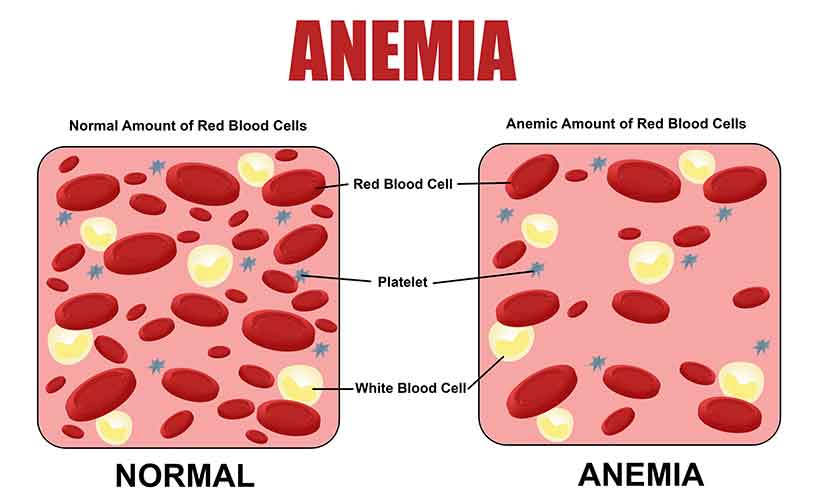
We touched on mineral deficiencies in the last point, but fe deficiency anemia deserves a mention of its own.
Sadly, iron deficiency anemia is a growing epidemic around the world.
In a developed state such as the Usa, nutrient deficiencies shouldn't exist a crusade of decease, nevertheless anemia kills thousands every year.
To exist exact, the latest release of statistics showed that Anemia hospitalized 146,000 Americans in one twelvemonth. 5,219 of these people died (17).
Globally it'south even worse, and according to the World Health Organization, 1.62billion people suffer from iron deficiency anemia (18).
Heme and Non-Heme Iron
There are ii types of iron available in food, and nosotros refer to them as heme and non-heme atomic number 26.
- Heme Fe:Heme iron is the well-nigh bioavailable form of atomic number 26, and meat and other animal foods exclusively contain it.
- Not-Heme Iron: Non-heme iron is constitute in plant foods such as fruit, vegetables, and nuts. In comparing to heme iron, our body finds information technology more hard to absorb.
One of the best health benefits of beef meat is that information technology contains a substantial corporeality of heme fe.
The best source of all? Beef liver.
Interestingly, anemia disproportionately affects females. Perhaps this isn't a huge surprise when we think near how gild seems to shame women who eat meat.
The imagery of women smiling while eating a bowl of salad is quite ubiquitous.
Central Point: Eat more than beefiness to assistance preclude iron deficiency anemia.
6. Beef Contains Carnosine
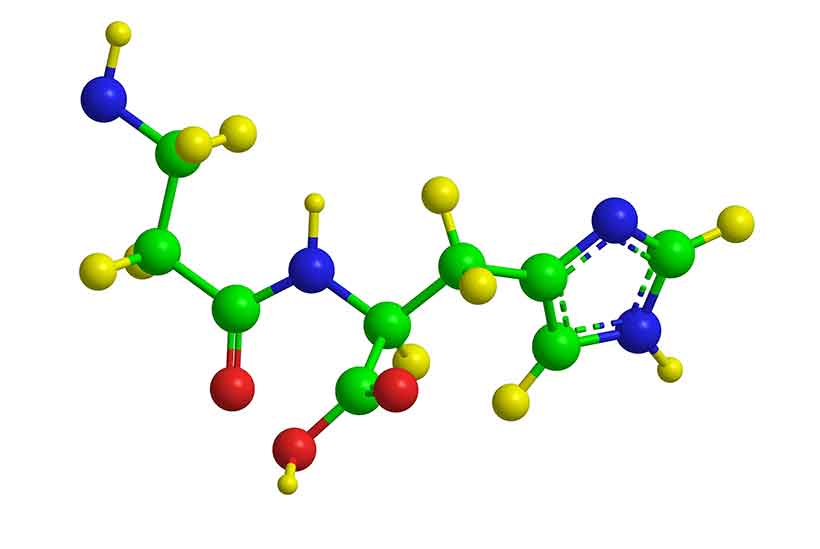
Another potential advantage of eating beefiness is that it provides an affluence of carnosine.
Carnosine (beta-analyl-Fifty-histidine) is a compound created by the combination of the amino acids alanine and histidine. It is establish throughout the torso, and information technology has several important roles in human health.
As beef is i of the highest sources of carnosine (containing near fifty% more than poultry), this is another health benefit.
What Does Carnosine Practice?
For one affair, carnosine has anti-glycosylation backdrop.
To be exact, carnosine reduces the harms of a process chosen 'glycation' which involves advanced glycation end-products (AGES).
Glycation is central to the aging procedure and progressively damages our body, potentially leading to atherosclerosis and various other chronic diseases (xix, xx).
Additionally, carnosine helps boost the immune system and reduce inflammation. The chemical compound is also thought to help foreclose lipid peroxidation within our cells (21, 22).
Key Point: Beef (and reddish meat in general) is the best dietary source of carnosine.
7. Beefiness is Total of Vitamins
There are many important nutrients in beefiness, and those present in significant amounts include the range of B vitamins (eleven);
| Vitamin Name | Corporeality Per 6oz Portion (% RDI) |
| Vitamin B12 | 82 |
| Vitamin B3 | 50 |
| Vitamin B6 | 36 |
| Vitamin B2 | 18 |
| Vitamin B5 | 14 |
Additionally, beef also contains smaller amounts of vitamins E and Thou.
Vitamin B12 (cobalamin) is a notably essential food, and this is because it is only available from animal foods.
This vitamin besides has a wealth of benefits that include peel improvements, positive mood, ameliorate slumber, and neural regeneration (23, 24).
It's important to realize that insufficient vitamin B12 may as well increase the risk of low and mental health issues (25, 26).
Fortunately, just 100 grams of beef provides the daily recommended amount of B12.
Fundamental Point: Beef is high in B vitamins which assistance promote wellness. Vitamin B12 is particularly important since information technology isn't present in plant-based foods.
8. Conjugated Linoleic Acid
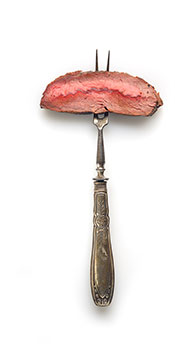
Otherwise known equally CLA, conjugated linoleic acid is a naturally occurring trans-fatty.
Don't worry, although the "trans-fat" name is a little scary, information technology has a very unlike result to the synthetic version.
Some randomized controlled studies involving man participants suggest that;
- Conjugated linoleic acid might help to ameliorate insulin sensitivity (27)
- CLA may slightly promote fat loss, but the testify is mixed (28, 29)
Notably, the bulk of the testify suggests that getting CLA from real food is amend than supplementation (xxx).
Equally is often the example, mayhap nutrients in whole foods have a different result to a synthetic pill?
Nutrient Sources of CLA
The peak sources of CLA include meat and dairy products.
After lamb meat and certain cheeses, beefiness is the next highest provider of the nutrient.
Although all types of beefiness contain CLA, grass-finished meat offers a significantly higher amount than beefiness from grain-fed cattle.
Specifically, the average amount of CLA in grass-fed beef is 0.46% of the fat content.
With grain-fed beef, this boilerplate content drops to 0.xvi% of fat (31).
Key Point: Beef—particularly from grass-fed cows—is one of the highest sources of conjugated linoleic acid.
ix. Beef Contains Creatine
Almost everyone knows the dietary supplement version of creatine, but did you know that beefiness contains it besides?
In fact, beef typically contains 350mg creatine per 100g (32).
The health benefits that creatine bring include;
- Improved exercise performance
- Creatine assists in muscle growth and evolution
- Provides muscles with greater energy supply and improves endurance
- Increased muscular size
It'due south also worth noting that our liver can produce near 2g creatine per day, depending on the pre-cursors being available.
Creatine precursors include arginine, glycine, and methionine (33).
Non only are all of these amino acids present in beefiness, but beef is one of the single about meaning dietary sources for them.
In other words, eating beef gives yous a decent amount of dietary creatine, and information technology helps your body to produce it also.
Central Point: Beefiness has 2 positive impacts on creatine levels. Firstly, it direct provides information technology to the body and secondly, it helps the torso to make information technology.
Final Thoughts
Beef contains several wellness-promoting compounds, some of which many of united states don't consume in sufficient amounts.
While there are as well some concerns about crimson meat worth considering, beefiness supplies large amounts of benign nutrients to the average diet.
Peculiarly protein, iron, zinc, and vitamin B12.
Related Articles
Is Steak Healthy?
The Steak and Eggs Nutrition: An Old-School Diet For Weight Loss?
Source: https://www.nutritionadvance.com/health-benefits-eating-beef/
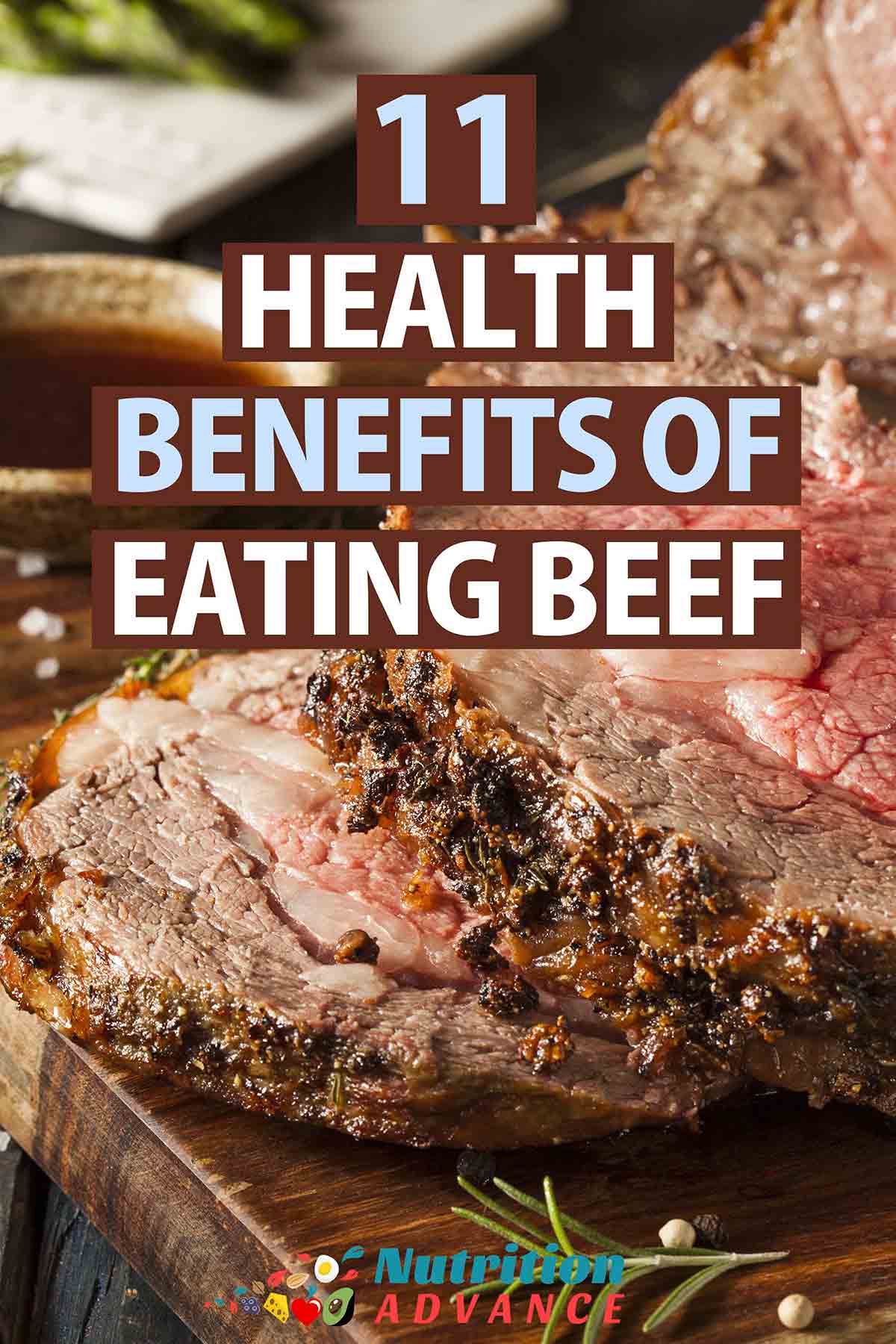
0 Response to "What Are the Benefits of Having Beef Cattle What Are the Benefits of Having Beef Cattle"
Enregistrer un commentaire